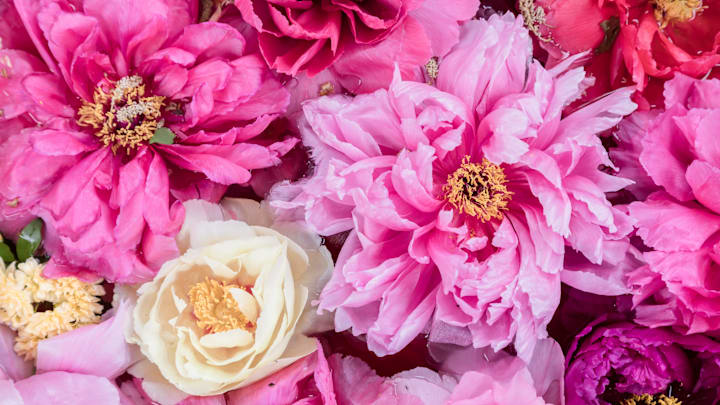With spring in bloom, let’s stop and smell the etymological roses. Here are the origins behind the names of 12 of the loveliest flowers.
- Anemone
- Amaryllis
- Carnation
- Chrysanthemum
- Daisy
- Forget-Me-Not
- Lupine
- Orchid
- Peony
- Rhododendron
- Tulip
- Violet
Anemone

The anemone is also known as the “windflower.” Indeed, the word anemone, first attested in English in the mid-1500s, probably comes from a Greek word literally meaning “daughter of the wind.” It’s said the brightly colored petals of this flower only opened when the wind blew. Sea anemones took their names in the late 1700s on their likeness to the flowers.
Amaryllis

In the pastoral poems of Theocritus, Ovid, and Virgil, Amaryllis was a common name for a beautiful country girl. Carl Linnaeus, the father of modern taxonomy, adopted amaryllis for this flower family in the late 1700s. The name amaryllis may derive from a Greek verb meaning to “sparkle” or “shine,” fitting for the rich red veins that pop out from the long white petals of these flowers.
Carnation

There are two etymologies for carnation, a term found in English in the early 1500s. According to one, carnation may be a corruption of coronation, perhaps because the flower’s toothed petals resembled crowns or because the flowers were worn, crown-like, as garlands [PDF]. The second etymology comes from the flower’s original color, and roots carnation in the Middle French carnation, “pink complexion,” from the Latin root caro, “flesh,” the source of less delicate words like carnal and carnage.
Chrysanthemum

True to their etymology, chrysanthemums often bloom in striking gold. The word chrysanthemum, emerging in English in the late 1500s, comes from the Greek krysanthemon, meaning “gold flower.” The first component, krysos (“gold”), shows up in the biological term chrysalis. The second, anthos (“flower”), appears, among other words, in anthology, literally “a collection of flowers,” first used for a compilation of small poems in the early 1600s. Chrysanthemums also answer to mums, a shortening evidenced in the history of the word since the late 1800s.
Daisy

The word daisy has deep roots in the English language. As attested to in some of English’s earliest records, daisy comes from the Old English phrase dægesege: the “day’s eye,” as the flower’s white petals close at dusk and open at dawn, like the eye of the day as it sleeps and wakes.
Forget-Me-Not

The name forget-me-not was a direct translation from the Old French ne m’oubliez mye (“do not forget me”). Renaissance romantics believed that if they wore these soft-colored flowers, they would never be forgotten by their lovers, making the flower a symbol of fidelity and everlasting love. Other languages also translated ne m’oubliez mye: For this flower, German has Vergissmeinnicht, Swedish has förgätmigej, and Czech has nezabudka.
Lupine

The tall, tapering blue clusters of lupines certainly don’t look like their etymology: lupinus, a Latin adjective for “wolf.” So why the fierce name? Perhaps the flowers were once thought to deplete the ground in which they grow, devouring its nutrients like a wolf. This is likely folk etymology, though, as lupines actually enrich the soil and have long been harvested for their nutritious seeds.
Orchid

Orchids are a diverse family of elegant flowers, but the literal meaning of their name, documented in English in the early 1840s, is a bit earthier, shall we say. Orchid comes from the Greek orkhis, meaning “testicle.” The flower’s bulbous roots, often paired, have long been thought to resemble the organs.
Peony

Peony, a word found in Old English, described a flower believed to have healing properties in early medicine, which is why its name might honor Paion, the physician of the gods in Greek mythology. The name Paion might come from a root Greek verb meaning “touch,” hence “one who touches,” hence “heals.” His name also gives us paean, “a song of praise,” as Paion became identified with Apollo, Greek god of music and poetry.
Rhododendron

Like many other flower names, rhododendron enters the English record in the mid-1500s. The name literally means “rose tree” in Greek (rhodon means and is related to the word “rose”). It’s an apt name, for this shrub or small tree blooms with brilliant, rose-colored flowers. After Latin grafted the word, rhododendron took another path, its rs and ds eventually arranged into the name of another blossoming plant: oleander.
Tulip

Contrary to the grade-school groaner, tulip does not come from the fact that the flower can look like two lips kissing. Passing into English via Dutch or German in the late 1500s, tulip actually comes from the Turkish tülbent, based on the Persian dulband: “turban.” The flower, to its ancient namers, resembled the male headwear worn throughout the Middle East, India, and parts of Africa. The word turban also comes from this Persian dulband.
Violet

Before we had the word for the color, recorded by the late 1300s, we had the word for the flower, emerging some decades earlier in the same century. Violet grows out of the French violete or violette, a diminutive of viole, in turn the Latin viola, its name for this distinctively purple flower. This viola has no etymological relationship to the instrument. Some scholars suspect Latin got viola from the Greek name for the plant, ion, also with no etymological relationship to the molecule. Greek “floral” ion, though, does show up in chemistry. The name of the element iodine was ultimately coined from the Greek ioeides, “violet-colored,” because the substance emits a violet-colored vapor.
Read More About Flowers Here:
A version of this story originally ran in 2021; it has been updated for 2024.
